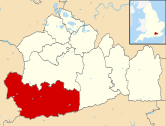The Royal School, Haslemere
| The Royal School, Haslemere | |
|---|---|
 | |
| Address | |
 | |
Farnham Lane , Surrey , GU27 1HQ England | |
| Information | |
| Type | Private day and boarding |
| Motto | ‘Per Aspera Ad Astra’ |
| Religious affiliation(s) | Church of England |
| Established | 1840 |
| Founder | Vice-Admiral Sir Jahleel Brenton, Admiral Sir Thomas Williams and Captain Hon. Francis Maude established The Royal Naval School |
| Department for Education URN | 125348 Tables |
| President | HRH The Princess Royal |
| Headmaster | Mr Paul Norman |
| Staff | 80 |
| Gender | Mixed |
| Age | 10 to 18 |
| Enrolment | 200 |
| Houses | Balmoral
Buckingham Sandringham Windsor |
| Affiliation | United Church Schools Trust |
| Website | http://www.royal-school.org/ |
The Royal School, Haslemere is a private co-educational day and boarding school for boys and girls aged 10 to 18. The original Royal Naval School was founded for the daughters and sisters of Naval and Marine Officers in 1840. From the outset the founders’ ambition was for the girls to become independent. The school began accepting boys in 2011 and then became fully co-educational in 2019 when The Royal School joined United Learning, which is a group of schools operating both in the independent and maintained sectors and which is, itself, a charitable trust dating back to the late 19th Century. The school operates exclusively from one site on Farnham Lane, Haslemere in Surrey, England. It has a foundation in Christianity.
History
[edit]The original Royal Naval School was founded in 1840 as The Royal Female School for the daughters of Naval and Marine Officers, one of the earliest academic girls' schools in England. The co-ancestor of The Royal School, The Grove School, was founded in the 1850s and was, equally, a pioneer in girls' education. From the outset, the founders' ambition was for the girls to become independent.
The Royal Naval School
[edit]In 1815, the Battle of Waterloo finally put an end to the Napoleonic Wars. In the following peaceful years, the Navy was put on half or even quarter pay. Peace also brought an end to the prize money from captured ships, as the Navy had been at war nearly non-stop since the 1770s, the potential for Senior Officers to become wealthy and to set themselves up as country gentlemen had become established. The peace brought significant changes to their way of life. After Waterloo, many Naval Officers found themselves in financial difficulty. They were able to send their young sons from age nine upwards to sea as mid-shipmen where they would gain an education and valuable experience. Their daughters, however, were in a more difficult position. They were too high up the social ladder to engage in any menial work to earn their own living but too poor to attract the attention of eligible husbands. Vice-Admiral Sir Jahleel Brenton, Admiral Sir Thomas Williams and Captain Hon. Francis Maude established The Royal Naval Female School as it was then known, specifically to provide a sound education which would enable the girls to go out into employment almost certainly as teachers and governesses. The school was founded for the daughters and sisters of Naval and Marine Officers. Queen Victoria and the Queen Dowager were among the first subscribers and from the outset the School had the patronage of The Queen. The Patron, Her Majesty Queen Elizabeth II, opened the QEII Sixth Form building in 1989. In 1975 Princess Anne inherited the Presidency from her great-uncle, Lord Mountbatten of Burma, after whom the science and languages block is now named. Princess Anne has visited the school, her most recent visit being for Prize Day in 2023. The Princess Anne Sports Hall (P.A.S.H) was opened by her in 1986.
The Grove School
[edit]The history and legacy of The Grove School's inheritance is notable for its intellectual adventurousness, offering a comprehensive and thorough education from its inception. The school was founded by Mrs. Lacey, a staunch advocate for women's education at a time when it was often undervalued. The Lacey family's commitment to education and their Christian faith can be traced through generations, with their name appearing in The Grove's records and beyond, associated with educational and missionary endeavors abroad.
In addition to providing lessons within its own establishment, The Grove School also organized extension classes at the University College of Nottingham, which was established in 1881. These classes were well attended by both teachers and pupils, showcasing the school's dedication to academic pursuits.
From the very beginning, The Grove School combined a strong commitment to charity work, particularly in aiding disadvantaged girls in London, with its academic ambitions. Notably, a number of the school's pupils were among the pioneering female students to attend prestigious universities such as Oxford and Cambridge. Miss Lacey, the second Headmistress who succeeded her mother, Mrs. Lacey, achieved a first-class degree in Modern History in the 1890s, highlighting the school's emphasis on academic excellence.
It is worth mentioning that recognition of academic achievements for women, particularly regarding degrees, was limited during the time period. It was not until the 1920s when Oxford formally decided to confer degrees on female students that individuals like Miss Lacey, who had already accomplished considerable academic success, received the recognition they deserved.
The Royal School
[edit]The two schools joined together in 1995. The pupils are accepted from six weeks (for daycare) and up to 18 years. There are elements of the uniform that have a historical connection – the girls' suit jackets are cut short in the naval style and the tippets are as used at the funeral of Queen Alexandra in 1925.
The founder schools were among the first to take the education of girls seriously.
References
[edit]External links
[edit]- The Royal School Haslemere
- Profile on MyDaughter
- Independent Schools Inspectorate Inspection Reports

